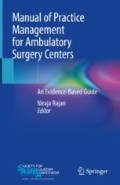Abstract
It is important to provide appropriate education and training to staff to promote a culture of safety in surgery centers. In this chapter, we will discuss mandatory staff trainings (e.g., Malignant Hyperthermia and fire), as well as recommended trainings to staff. The principles of Crisis Resource Management and various team based approaches can be incorporated into education/training to foster inter-professional teamwork and improve performance. In addition, as a part of team work training, cognitive aids can be utilized to reduce human errors and enhance staff communication.
Access this chapter
Tax calculation will be finalised at checkout
Purchases are for personal use only
References
Goldfarb CA, Bansal A, Brophy RH. Ambulatory Surgical Centers: a review of complications and adverse events. J Am Acad Orthop Surg. 2017;25(1):12–22.
Woods DM, Thomas EJ, Holl JL, Weiss KB, Brennan TA. Ambulatory care adverse events and preventable adverse events leading to a hospital admission. Qual Saf Health Care. 2007;16(2):127–31.
Gaba DM. Crisis resource management and teamwork training in anaesthesia. Br J Anaesth. 2010;105(1):3–6.
Miller RB. In: Edition 8th, editor. Miller’s anesthesia, vol. 1. Philadelphia: Elsevier Saunders; 2015. p. 121–4.
Reason J. Understanding adverse events: human factors. Qual Health Care. 1995;4(2):80–9.
Neily J, Mills PD, Young-Xu Y, et al. Association between implementation of a medical team training program and surgical mortality. JAMA. 2010;304(15):1693–700.
Renna TD, Crooks S, Pigford AA, et al. Cognitive Aids for Role Definition (CARD) to improve interprofessional team crisis resource management: an exploratory study. J Interprof Care. 2016;30(5):582–90.
Marshall S. The use of cognitive aids during emergencies in anesthesia: a review of the literature. Anesth Analg. 2013;117(5):1162–71.
Harrison TK, Manser T, Howard SK, Gaba DM. Use of cognitive aids in a simulated anesthetic crisis. Anesth Analg. 2006;103(3):551–6.
Hand WR, Bridges KH, Stiegler MP, et al. Effect of a cognitive aid on adherence to perioperative assessment and management guidelines for the cardiac evaluation of noncardiac surgical patients. Anesthesiology. 2014;120(6):1339–49, quiz 1349–1353.
Evans D, McCahon R, Barley M, Norris A, Khajuria A, Moppett I. Cognitive Aids in Medicine Assessment Tool (CMAT): preliminary validation of a novel tool for the assessment of emergency cognitive aids. Anaesthesia. 2015;70(8):922–32.
Degani A, Wiener EL. Cockpit checklists: concepts, design, and use. Human Factors J Human Factors Ergonomics Soc. 1993;35(2):345–59.
Dunn EJ, Mills PD, Neily J, Crittenden MD, Carmack AL, Bagian JP. Medical team training: applying crew resource management in the Veterans Health Administration. Jt Comm J Qual Patient Saf. 2007;33(6):317–25.
King HB, Battles J, Baker DP, et al. TeamSTEPPS TM: team strategies and tools to enhance performance and patient safety. In: Henriksen K, Battles JB, Keyes MA, Grady ML, editors. Advances in patient safety: new directions and alternative approaches. Vol 3: Performance and Tools. Rockville, MD: Agency for Healthcare Research and Quality; 2008.
Risser DT, Rice MM, Salisbury ML, et al. The potential for improved teamwork to reduce medical errors in the emergency department. Ann Emerg Med. 1998;34(3):373–83.
Makary MA, Sexton JB, Freischlag JA, et al. Operating room teamwork among physicians and nurses: teamwork in the eye of the beholder. J Am Coll Surg. 2006;202(5):746–52.
Mills P, Neily J, Dunn E. Teamwork and communication in surgical teams: implications for patient safety. J Am Coll Surg. 2008;206(1):107–12.
Sexton JB, Helmreich RL, Neilands TB, et al. The Safety Attitudes Questionnaire: psychometric properties, benchmarking data, and emerging research. BMC Health Serv Res. 2006;6:44.
Undre S, Koutantji M, Sevdalis N, et al. Multidisciplinary crisis simulations: the way forward for training surgical teams. World J Surg. 2007;31(9):1843–53.
Moorthy K, Munz Y, Adams S, Pandey V, Darzi A. A human factors analysis of technical and team skills among surgical trainees during procedural simulations in a simulated operating theatre. Ann Surg. 2005;242(5):631–9.
Arriaga AF, Bader AM, Wong JM, et al. Simulation-based trial of surgical-crisis checklists. N Engl J Med. 2013;368(3):246–53.
Apfelbaum JL, Hagberg CA, Caplan RA, et al. Practice guidelines for management of the difficult airway: an updated report by the American Society of Anesthesiologists Task Force on Management of the Difficult Airway. Anesthesiology. 2013;118(2):251–70.
Rosenberg H, Pollock N, Schiemann A, Bulger T, Stowell K. Malignant hyperthermia: a review. Orphanet J Rare Dis. 2015;10:93.
Managing a Crisis. 2017; https://www.mhaus.org/healthcare-professionals/managing-a-crisis/.
Sekimoto K, Tobe M, Saito S. Local anesthetic toxicity: acute and chronic management. Acute Med Surg. 2017;4(2):152–60.
Verlinde M, Hollmann MW, Stevens MF, Hermanns H, Werdehausen R, Lirk P. Local anesthetic-induced neurotoxicity. Int J Mol Sci. 2016;17(3):339.
Neal JM, Bernards CM, Butterworth JF, et al. ASRA practice advisory on local anesthetic systemic toxicity. Reg Anesth Pain Med. 2010;35(2):152–61.
Author information
Authors and Affiliations
Corresponding author
Editor information
Editors and Affiliations
Rights and permissions
Copyright information
© 2020 Springer Nature Switzerland AG
About this chapter
Cite this chapter
Chiu, C., Kinjo, S. (2020). Education and Training: Staff and Facility. In: Rajan, N. (eds) Manual of Practice Management for Ambulatory Surgery Centers. Springer, Cham. https://doi.org/10.1007/978-3-030-19171-9_18
Download citation
DOI: https://doi.org/10.1007/978-3-030-19171-9_18
Published:
Publisher Name: Springer, Cham
Print ISBN: 978-3-030-19170-2
Online ISBN: 978-3-030-19171-9
eBook Packages: MedicineMedicine (R0)

